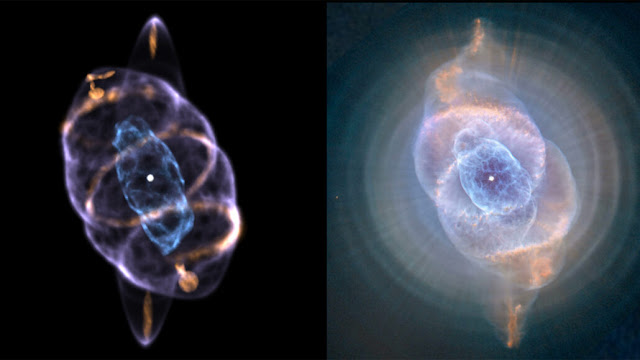A high school student's curiosity revealed the structure of the nebula.
One of the most complex and least understood nebulae, a whirling landscape of gas and dust left in the wake of a star's death throes, is about 3,000 light-years from Earth. A new computer visualization reveals the 3-D structure of the Cat's Eye nebula and hints at how it was sculpted by not one, but two dying stars.
Based on Hubble Space Telescope images, the digital reconstruction reveals two symmetric rings around the nebula's edges. Ryan Clairmont and colleagues report in the October Monthly Notices of the Royal Astronomical Society that the rings were most likely formed by a spinning jet of charged gas launched from two stars in the nebula's center.
"I realized there hadn't been a comprehensive study of the structure of the nebula since the early '90s," says Clairmont, a Stanford University undergraduate. Last year, as a high school student in San Diego, he contacted a couple of astrophysicists at Ilumbra, a scientific imaging company that had developed software to reconstruct the 3-D structure of astronomical objects.
The team combined Hubble images with ground-based observations of light at various wavelengths to reveal the nebula's gas motions. Identifying which parts were moving toward and away from Earth aided in revealing its three-dimensional structure.
The researchers discovered two partial rings on either side of the nebula's center. The rings' symmetry and unfinished nature indicate that they are the remains of a plasma jet launched from the nebula's heart and suffocated before it could complete a full circle. According to Ilumbra partner Wolfgang Steffen, who is based in Kaiserslautern, Germany, such jets are usually formed by an interaction between two stars orbiting each other.
Clairmont's work was recognized at the 2021 International Science and Engineering Fair, an annual competition sponsored by the Society for Science, which publishes Science News. Steffen was skeptical of the short deadline — when Clairmont contacted him, he had only two months to finish the project.
"I said it was impossible!" "No one has tried that before, not even Ph.D. students," Steffen says. "He did an excellent job. He accomplished everything we had hoped for and more."
CITATIONS
N. Koning, R. Clairmont, and W. Steffen. Morphokinematic modeling of NGC 6543's point-symmetric Cat's Eye: A precessing jet's ring-like remnants. Monthly Notices of the Royal Astronomical Society, October 2022, Vol. 516, p. 2711. The citation is 10.1093/mnras/stac2375.

